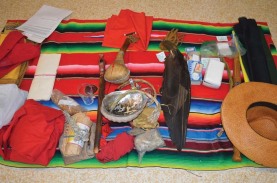Powerful Pipe Ceremony
I say “powerful,” because that is what it truly was for me.
On Monday, I had the opportunity to participate in a Pipe Ceremony, facilitated by Elder Alma. I honestly was not sure what to expect. I usually cannot be around a room filled with smoke, as it irritates my eyes and throat. However, this was different. I wasn’t bothered by the smell of the tobacco burning. I felt calm; the whole room felt calm. There was so much peace and faith all around me. When the pipe was being passed around, it reminded me of my church in a way (going up to get the Holy bread). This connection that I made to my own faith and identity encouraged me to think about how important this ceremony is to Indigenous peoples. In the past, Indigenous peoples’ identities were stolen and they were forced to learn new ways of life and throw away their old celebrations, ceremonies, etc.
I thought about my own faith and my own way of celebrating. I could not imagine having that being taken away from me. Elder Alma was so inviting as she allowed every one of us to experience a beautiful healing and prayerful ceremony. I could tell that the smoke from the pipe meant so much more than just physical smoke. Alma mentioned that the pipe is the connection from the earth to the sky. The prayers that we say and think are the smoke which rises up into the sky so that our prayers can be answered. Again, this made me form a connection to my own beliefs and faith. It fascinated me to think about.
I participated, not knowing how I’d feel afterwards. I came out of it feeling like I learned about prayer, respect, love, healing, tradition, connection, and ceremony. My hope is that if more people (of any race, culture, age) participated in pipe ceremonies like the one I did, that more people would feel the same way as I do.
 This picture that I found on Google, reminds me of what I saw at the pipe ceremony that I experienced with our class and Alma.
This picture that I found on Google, reminds me of what I saw at the pipe ceremony that I experienced with our class and Alma.

